Birds Have maximum of 5 digits (Toes) in each of their foot. These are arranged in different ways in different species. to avoid confusion in their classification, they are numbered in order with the Toe attached to inside the foot as 1 and the one on the outside as 5 . The birds have very thin legs that are adapted more to grasping of prey or nesting material, they have to balance on their toes. This has resulted in them having one or more toes facing back of their foot to provide the balance. Usually the Toe 1 is facing the backwards. This toe is called HALLUX
The 5th toe is absent in many birds . It might be because it is an hindrance to the bird as it has to walk on different substrates. The birds have evolved over years to loose it and this has also made their feet lighter aiding flight. In some species it has evolved into a small spike at the back of the lower leg. It is called TARSAL SPUR. This is more common in ground dwelling birds like fowls. It is seen mainly in males and is used for fighting and to calm the females during mating

The arrangement of the toes leads to various types of feet structures.
ANISODACTYL : The most common arrangement is Three toes facing forward and one facing backward ( Usually the Toe 1) . Variations on this structure are seen with HALLUX being smaller or raised above the ground like in Ducks , Pratincoles and stilts.
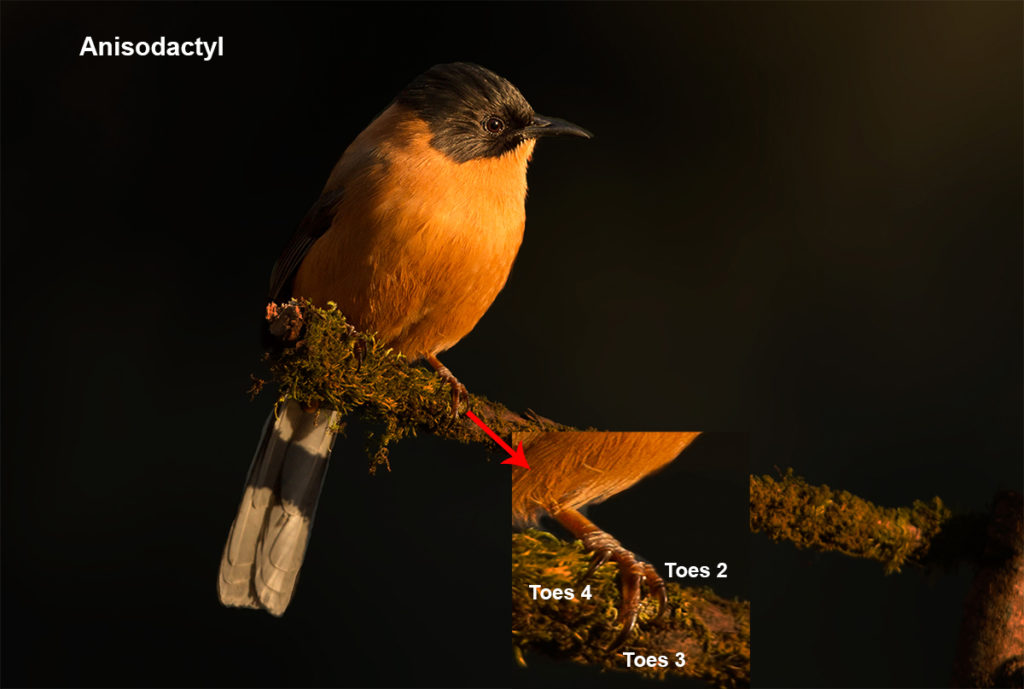
PAMPRODACTYL : When the HALLUX is reversible and can be brought forward to join the other three toes the arrangement is called PAMPRODACTYL. But as this arrangement is only temporary and the bird does this at will it is called SEMI-PAMPRODACTYL. 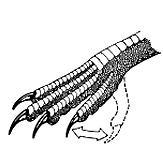 This is done by birds when they need additional support for their bodies , like when they are hanging from Cliff, Creepers etc.
This is done by birds when they need additional support for their bodies , like when they are hanging from Cliff, Creepers etc.
SYNDACTYL : In some cases the Front toes are joined for part of their length. 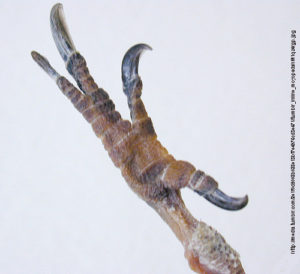 The outer toes number 3&4 are usually joined . This can be seen in Kingfisher & Bee Eaters.
The outer toes number 3&4 are usually joined . This can be seen in Kingfisher & Bee Eaters.
ZYGODACTYL : In this arrangement there are two toes facing front and two facing backwards ( Toe 1 & 4 face backwards, Toe 2 &3 forward) . This can be Permanent like Woodpecker, Barbet, Parrots & Coucals, or SEMI -ZAGODACTYL when the toe 4 can be reversed at the will of the bird and Bird can become a SEMI -ZAGODACTYL from ANISODACTYL like in Owls and Osprey. This arrangement gives the bird extra dexterity and support when they are clambering in vegetation , climbing trees and vertical surfaces.

Permanent Zygodactyl Semi -Zygodactyl
HETRODACTYL : Very similar to ZYGODACTYL ( 2 toes forward and two toes backwards) but the toe numbers are different. In this case the Toes 1 &2 face backwards and Toes 3&4 face forward. This can be seen in Trogons
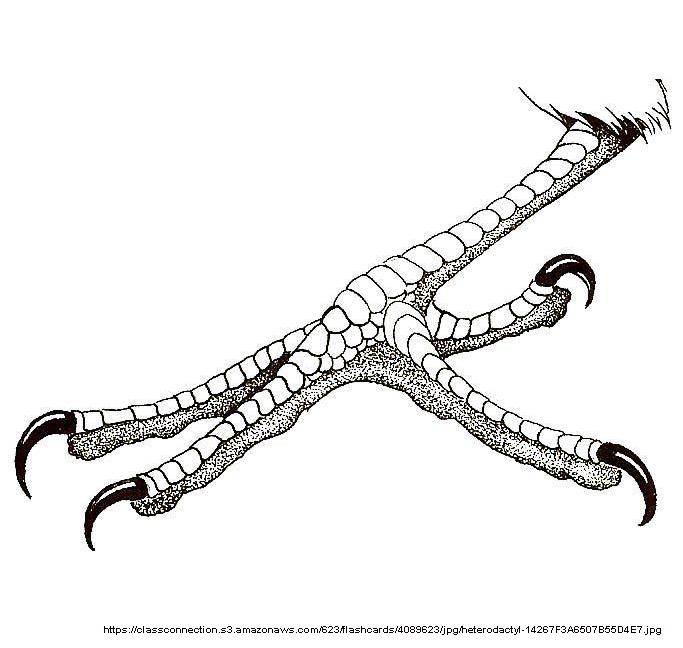
WEBBED : Water birds use their feet for swimming. For this they need large surface areas on their feet to propel forward. They have chosen the lightest option is to attach all the toes. They have a thin layer of skin connecting all the toes , this is called a WEB. Only the front facing toes have Webs that are either all the way to the end of the toes (Fully Webbed) or part of toes ( Partially webbed). The former can be seen in Dabbling Ducks and geese. that swim in water while the latter can be seen in Storks and Ibises that wade in the water. The webbed feet gives them better balance to walk on soft mud .

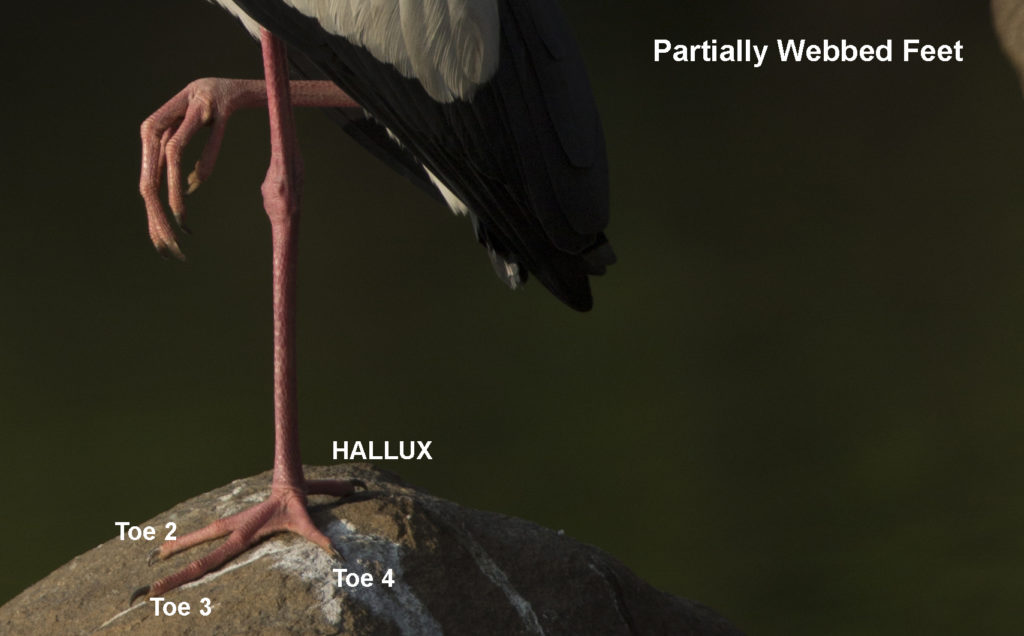
TOTIPALMATE : For birds that have to dive deeper inside water to catch prey , they need high propulsion. For this they have connected the HALLUX also to the web. This gives them ability to dive deep and catch prey. But the disadvantage is that their feet are not useful for walking and as their legs are already set wide apart to facilitate diving , they have a very cumbersome Waddle like walk on the land . This can be seen in Diving Ducks, Cormorants and Pelicans.

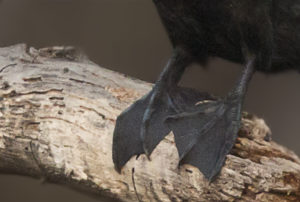
The webbed Feet is also used for Incubation of eggs as this is not covered with feathers and this can pass on heat to the eggs. So the Birds gently place their feet on the eggs or sometimes the eggs are balanced on the feet using the bill
Other Interesting toes structures can be seen in jacana with Long Toes compared yo their leg size. this helps them walk on floating vegetation


In some cases the front facing toes can be reduced to vestigial like 2nd toe in Aquatic Kingfisher and 4th toes in Hawks
The larger the surface area more the friction and resistance, hence the ground dwellers have lost the HALLUX completely. This is exhibited by Plovers, Bustards , Lapwings & Button quails.
Some water birds like the Coots , grebes, Phalarope do not have webs but have flattened their skin and flesh in area around the toes to form tough lobes that perform the function like the webbed feet. The advantage that these birds have is that they can also use their toes individually for climbing on to floating vegetation or nests
With the ability to change their feet structure and the ability to fly and swim the birds have adapted themselves to the surrounding better than most of the species in animal kingdom